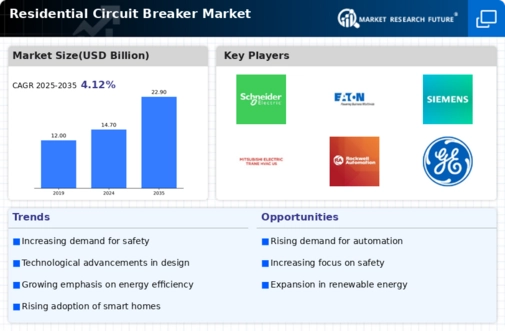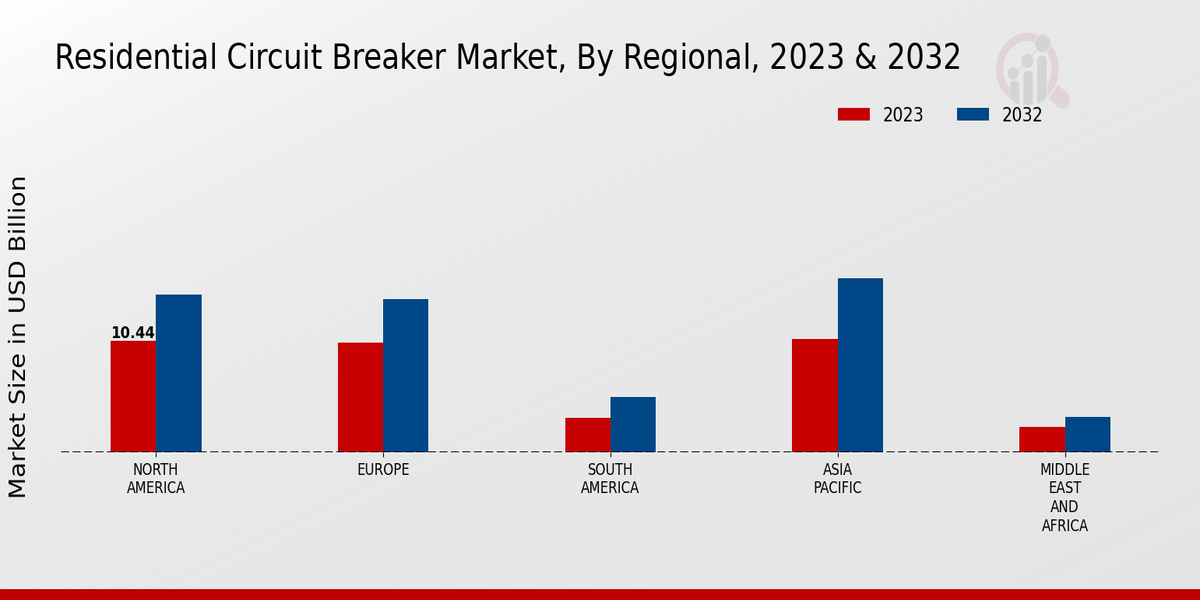Market Growth Projections
The Global Residential Circuit Breaker Market Industry is projected to experience substantial growth over the coming years. With a market value of 14.7 USD Billion in 2024, it is anticipated to reach 22.9 USD Billion by 2035. This growth trajectory suggests a compound annual growth rate (CAGR) of 4.12% from 2025 to 2035. Such projections indicate a robust demand for circuit breakers driven by factors such as increased residential construction, technological advancements, and heightened safety awareness. The market's expansion reflects the critical role of circuit breakers in modern electrical systems, ensuring safety and efficiency in residential applications.
Regulatory Compliance and Standards
The Global Residential Circuit Breaker Market Industry is shaped by stringent regulatory compliance and standards that govern electrical installations. Governments worldwide are implementing regulations to ensure the safety and efficiency of electrical systems in residential buildings. Compliance with these standards is not only mandatory but also influences consumer purchasing decisions. Manufacturers are compelled to innovate and produce circuit breakers that meet or exceed these regulations, thereby enhancing product quality and reliability. As the market evolves, adherence to regulatory frameworks is expected to drive the demand for advanced circuit breakers, contributing to the overall growth of the industry.
Growing Demand for Energy Efficiency
The Global Residential Circuit Breaker Market Industry is witnessing a surge in demand for energy-efficient solutions. As consumers become increasingly aware of energy consumption and its environmental impact, there is a notable shift towards products that enhance energy efficiency. This trend is further supported by government initiatives promoting energy conservation and sustainable practices. In 2024, the market is projected to reach 14.7 USD Billion, indicating a robust growth trajectory. The emphasis on reducing energy costs and minimizing carbon footprints is likely to drive innovation in circuit breaker technology, aligning with global sustainability goals.
Increased Awareness of Electrical Safety
The Global Residential Circuit Breaker Market Industry is benefiting from heightened awareness regarding electrical safety among homeowners. As incidents of electrical fires and accidents continue to be reported, consumers are increasingly prioritizing safety features in their electrical systems. This awareness is driving the demand for high-quality circuit breakers that provide reliable protection against overloads and short circuits. Regulatory bodies are also emphasizing safety standards, which further propels the market forward. The combination of consumer awareness and regulatory pressure is likely to sustain growth in the circuit breaker segment, ensuring that safety remains a focal point in residential electrical installations.
Rising Residential Construction Activities
The Global Residential Circuit Breaker Market Industry is significantly influenced by the ongoing expansion of residential construction activities. As urbanization accelerates, there is a corresponding increase in the number of new homes being built, which necessitates the installation of reliable electrical systems. This trend is particularly pronounced in developing regions, where infrastructure development is a priority. The projected growth of the market to 22.9 USD Billion by 2035 underscores the importance of circuit breakers in ensuring electrical safety and compliance with building codes. Consequently, the demand for advanced circuit breakers is expected to rise in tandem with construction activities.
Technological Advancements in Circuit Breakers
The Global Residential Circuit Breaker Market Industry is experiencing rapid technological advancements that enhance the functionality and reliability of circuit breakers. Innovations such as smart circuit breakers, which offer remote monitoring and control capabilities, are gaining traction among consumers. These advancements not only improve safety but also facilitate energy management in residential settings. As the market evolves, the integration of Internet of Things (IoT) technology into circuit breakers is likely to become more prevalent. This trend may contribute to the market's projected CAGR of 4.12% from 2025 to 2035, reflecting a growing preference for intelligent electrical solutions.























